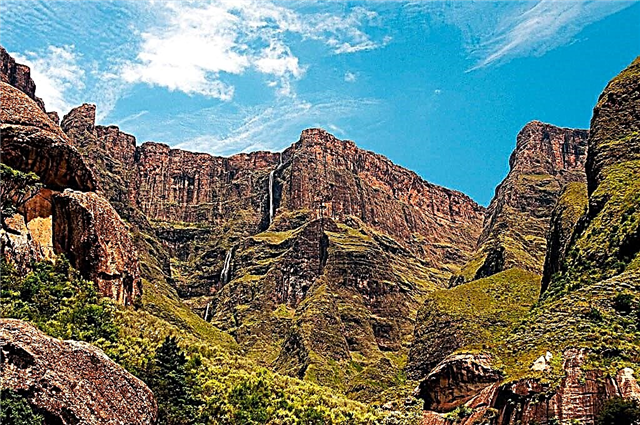Location: Mexico
Main attractions: temple of Kukulkan, temple of warriors, temple of jaguars, observatory, sacred cenote
Coordinates: 20 ° 41'01.0 "N 88 ° 34'08.4" W
Content:
Short description
The ancient Mayan city - Chichen Itza, located in Mexico in the north of the Yucatan Peninsula, is steeped in sinister glory. Right here, 300 meters north of the main buildings of the city is the Sacred Cenote, or "Well of Death" with a depth of about 50 meters, at the bottom of which, according to Mayan legends, the rain god Chak lived.

The ancient city of Chichen Itza from a bird's eye view
To appease God and cause rain, the Maya performed human sacrifices, throwing the most beautiful girls at the bottom of the well. Following the victims, rich gifts were thrown into the cenote - gold, jade, rock crystal, mother-of-pearl, amber, copper, onyx, etc.
The legend of the sacrifices was confirmed by Mexican scientists who sank to the bottom of the well. Although the well has not been used by the Maya for a long time, many people still believe in its supernatural power. It is believed that if you throw a coin into the water and make a wish, then it will certainly come true.

Temple of Kukulkan
A brief history of Chichen Itza
The name of the ancient city of Chichen Itza is translated as "Well of the Itza tribe." The city appeared in the 7th century AD e. as a Mayan religious center, and by the X century it was captured by the Toltecs who came to Yucatan from central Mexico, and by the XI century it became the capital of the Toltec kingdom. In 1178, the Indian ruler Hunak Keel sacked the Mayan sanctuary, turning it into a miserable heap of ruins. The city fell into decay and depopulated.

Temple of Warriors
Return of the Feathered Serpent
Chichen Itza is considered the most famous and best restored Mayan city. The main temple of Chichen Itza is dedicated to the deity Kukulkan - "The Feathered Serpent". The 30-meter pyramid of Kukulkan rises on a huge stone terrace. Four staircases, oriented to the cardinal points, lead to the top of the ritual structure, where the ancient Maya performed sacrifices. The stairs are framed by a balustrade that begins at the bottom with a serpent's head carved in stone and continues in the form of a curving serpentine body to the top of the pyramid.

Observatory
Every year on the days of the spring and autumn equinox, that is, March 20 and September 22, you can observe the unique phenomenon of the "Feathered Serpent": the sun illuminates the balustrade in such a way that the shadow of the "Feathered Serpent" is formed on the pyramid, which creeps down and disappears exactly 3 hours 22 minutes.
All four staircases of the temple have 91 steps, and together with the platform-terrace connecting them together, there are 365 steps (91 x 4 + 1), which corresponds to the number of days in a year.

Jaguar temple
Treasures of the pyramid of Kukulkan
In one of the secret rooms of the Kukulkan pyramid, archaeologists discovered the "Jaguar Mat" and the ritual figure of Chuck Mool with a flat bowl on his stomach, on which the heart of the sacrifice was burned. The Jaguar Mat is a throne carved out of stone in the shape of a jaguar body and painted a fiery red. The spots on the skin of the animal are made of jade stones. The eyes are also jade, and the fangs in the bared mouth are carved from volcanic stone.

Large ball field
Other attractions of Chichen Itza
Important buildings of Chitzen Itza are the Temple of Warriors and the Temple of the Jaguars, whose walls are decorated with paintings... So, in the Temple of the Jaguars, images of jaguars and eagles devouring human hearts are carved. On the south side of the Temple of Warriors is the "Group of a Thousand Pillars". It consists of the ruins of four colonnades that form a giant rectangle. There is in Chichen Itza and its own observatory "Caracol", designed to observe the planets and in particular for Venus.

Sacred cenote
It is a circular building with small windows that rises on a double stone platform. A spiral staircase was built inside this structure, which has a spiral shape like a mollusk shell. Hence the name of the observatory - "Caracol", which is translated from Spanish as "snail". One of the oldest buildings in the city - the Nuns' Palace is interesting for its stone carvings and masks of the god Chak. Chichen Itza has seven ball courts, including the largest "stadium" the Maya have ever built.

Venus platform
Since the ball game was of ritual significance for the Maya, the losers were sacrificed. The inhabitants of Chichen Itza were excellent craftsmen and artists. This is evidenced by the sculptures of deities preserved in the city, bas-reliefs with plant and geometric ornaments carved on them, handicrafts, etc. In 2007, according to the results of a popular vote, Chichen Itza was recognized as one of the seven new wonders of the world.











